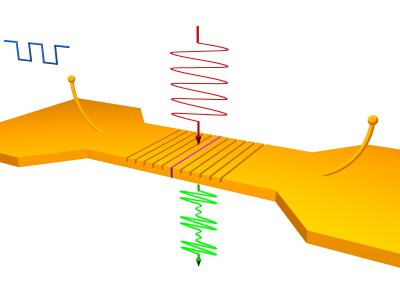Stanford researchers have developed a novel nonlinear optical device that miniaturizes electric-field-induced second harmonic light generation (EFISH) devices down to the size of nanoscale.
The novel device is a nanoscale light source having both electrical and optical functionalities. Physical forces, which make electrons to rotate in an orbit around a nucleus, are the basis of the device. It can be utilized to know fundamental science in a better way and for enhanced data communications.
 This schematic shows two gold electrodes separated by a nanoslit filled with a nonlinear material. Nanoscale grating on either side of the slit directs plasmonic waves toward the slit intensifying the light field by 80 times. A small voltage is applied to the electrodes producing a massive electrical field across the narrow slit producing an EFISH light source. Credit: Mark Brongersma
This schematic shows two gold electrodes separated by a nanoslit filled with a nonlinear material. Nanoscale grating on either side of the slit directs plasmonic waves toward the slit intensifying the light field by 80 times. A small voltage is applied to the electrodes producing a massive electrical field across the narrow slit producing an EFISH light source. Credit: Mark Brongersma
The new device looks like a nanoscale bowtie with two halves of symmetrical gold leaves separated by a slit filled with a nonlinear material of 100 nm width in the center. Mark Brongersma, one of the researchers, stated that EFISH needs a large electrical field. An electric field’s strength is inversely proportional to the distance between the two electrodes and augments linearly with the applied voltage. Hence, a single volt is sufficient to generate a huge electrical field when the electrodes placed at a nanoscale distance, he said.
Wenshan Cai, another researcher, stated that the team employed this fundamental science to reduce the size of the device from the human scale to the nanoscale. At this stage, the researchers used the principles of plasmonics, a study of an interesting physical phenomenon that happens due to the interaction between light and metal. When photons hit metal they generate energy waves that travel outward on the metal surface.
Researchers patterned the metal surface in such a manner that direct all of the energy waves toward the gap between the electrodes, resulting in the production of light with intensity 80 folds more than that of laser from which it originated. They then applied a modest voltage to the metal to generate an electrical field required for the production of an EFISH beam.
Brongersma stated that this kind of equipment could find utility in the communications industry on one day. This work couples various disciplines, including nanoscale engineering, plasmonics, electronics and nonlinear optics, he added.